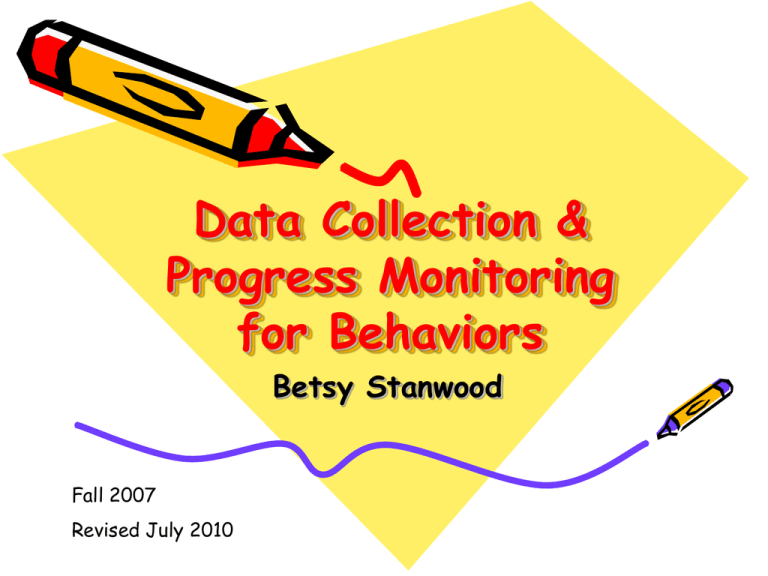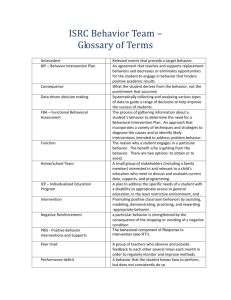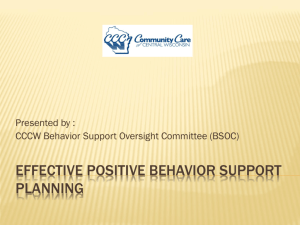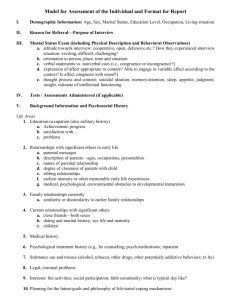Data Collection & Progress Monitoring for Behaviors
advertisement

Data Collection & Progress Monitoring for Behaviors Betsy Stanwood Fall 2007 Revised July 2010 First… A basic understanding of Positive Behavioral Interventions and Supports and How it fits with Problem Solving Model What is “Positive Behavioral Support”? PBIS focuses on PROACTIVE support strategies that reduce the likelihood of problem behavior allow individual students to be as independent and successful as possible in the school setting. encompass a range of strategies from systemic to individual supports PBIS Continuum Universal Interventions – proactive strategies supporting all students 5% 15% Intensive Interventions individualized strategies supporting students with high risk behaviors Targeted Interventions – specialized strategies supporting students with at risk behaviors 80% of Students Positive Behavioral Interventions & Supports Universal Targeted Intensive School-wide PBIS PSM Team / IAP / IEP PSM Team / IAP / IEP - System wide procedures - School wide systems - Classroom systems - Non classroom systems -PSM Interventions -IAP or IEP -Functional Behavior Assessment -Behavior Intervention Plan -Formal evaluation -Functional Behavior Assessment -Behavior Intervention Plan -Manifestation Determination -Short-Term Suspension Analysis Worksheet - Proactive management ideas - Informal/formal data collection and evaluation -Data collection, assessment, observation Mental Health in the Schools Problem Solving Continuum INTENSIVE 1–7% STRATEGIC 5 - 15 % CORE 80 - 90 % School-wide systems to support student achievement. Adapted from Sugai and Horner How Do the Processes Align? The most important alignment is that both support most students through “universal” school/classroom processes, some students through more “targeted” support, and a small group with the most “intensive” support Other Areas of Alignment Include: • • • • • • • • • • • Baseline data collection Analysis of data collected Problem definition Design interventions Identification of who, when, where teaching will occur Implementation of interventions Charting/Progress Monitoring Analysis of progress Continue implementation, change the interventions some, change the interventions significantly Continue with the review plan, intervene, analyze process Based in Behavior Analysis PSM PBIS Data Collection Collecting Data in Many Ways to Assist in the Development of Intervention Strategies Why do you need to collect data? • to implement best teaching practices • to report progress to parents • to collect information regarding a student or students’ performance • to address the I.D.E.A. “Special Factors” requirement for a student with an IEP • to monitor a behavior or the response to an intervention directed towards the behavior • to determine eligibility for accommodations or educational services Ways to Collect Data . . . Informal Basic Conduct Chart NAME: __________________________________ DATES:___________TO_______________ SCHEDULE BEHAVIOR #1 BEHAVIOR #2 BEHAVIOR #3 BONUS POINTS STEPS/HOME WORK/OR AGENDA TOTAL TEACHER COMMENTS: PARENT COMMENTS: From “Practical Charts for Managing Behaviors” by Lynn Lanvelle Time Increments Chart Student Name _________________________ BEHAVIOR 7:30 8:00 8:30 9:00 9:30 10:00 10:30 Date ____________ 11:00 11:30 12:00 12:30 1:00 1:30 2:00 2:30 COMMENTS Each Mark = 1 Point Morning Points Afternoon Points Parent Signature _____________________________________ From “Practical Charts for Managing Behaviors” by Lynn Lanvelle Ways to Collect Data . . . Formal Start time: 8:05 End time: 9:00 Setting: Seventh-grade math class Definition of behavior: Talking out is defined as any noise that is made without first raising hand in appropriate manner and waiting for permission to speak. Observer: Carol Burke (math teacher) Student Name Sammy Karen Chris Mon. 3/2/98 llll l llll Tues. 3/3/98 llll l lll Wed. 3/4/98 lll ll lll Thurs. 3/5/98 llll llll lll Key: Each tick mark represents one talk-out. Sample Event Record Fri. 3/6/98 ll l llll Ways to Collect Data . . . Formal Student: Bugs Bunny Start time: 8:05 End time: 8:15 Setting: seventh-grade English class Definition of behavior: On-task behavior is defined as appropriately writing, reading, talking about the assignment, or waiting to ask the teacher a question regarding the assignment. Observer: Daffy Duck (recess monitor) minute 10” 20” 30” 40” 50” 60” 1 O O X X X O 2 X O O O X O 3 X O O X O X 4 X X X O O X 5 O O X O X O 6 O X X X X X 7 X O O O O O 8 O X X X X O 9 X O O O X X 10 O X X O X O Key: O = Behavior was not observed at all during the 10-second interval. X = Behavior was observed at least once during the 10-second interval. 10” = 10 seconds. Sample Interval Recording Another Data Collection Tool -Tool Provided by Suzanne Rilling Sample Completed Data Collection Tool -Tool Provided by Suzanne Rilling Example Format for Data Collection FREQUENCY DATA SHEET Student: ______________ Date Time Behavior of Concern Exhibited Location/Activity Teacher: _________________ Presence of Others, Peers, Adult(Specify) Adult Response/Action Behavior: Tallies: NHCS PBIS 3 Tool Other Factors And Now What? Organize and Summarize • Record behaviors that can be seen and measured • Collect information across time and settings • Utilize multiple observers, if possible • Utilize data collection tools Be Specific Be Concise Be Descriptive Just the facts! Analyze the Data • Are there patterns? • Are there specific locations,times, subjects or people? (Triggers) • Are there physical signals of impending problems? • Are there home concerns? Divorce? Death? Illness? Transition? • How often do the behaviors occur? (frequency) • How long do behaviors last? (duration) • How severe or damaging are the behaviors? (intensity) • Can the student continue with their school day when behavioral episode is over? Example Format for Data Analysis Behaviors Of Concern (What student does) Frequency Intensity Duration (How often occurs per hour, day week) (How damaging or destructive: mild, moderate, severe) (How long lasts: minutes, hours) NHCS PBIS 4 Tool Intervention and Evaluation • Change aspects of the environment that trigger challenging behavior Teach the student more acceptable ways to get their needs met • Change aspects of the environment that happen following the behavior • • Collect data and evaluate impact of interventions on behavior Research What We Should Know About Behaviors What Does the Research Tell Us? George Batsche Professor of Psychological and Social Foundations Coordinator of Graduate Programs in School Psychology @ USF (University of South Florida) College of Education Specialty: Bullying, adolescent depression, aggression, violence prevention. Batsche has been on NBC Today, Oprah Winfrey and 20/20 on bullying, aggression and violence prevention. Focus on Tiers (Levels) I & II as General Education Requirement Tier I • Data on Office & Discipline referrals and Actions that took place • School wide Positive Behavioral Interventions and Supports • Second Step Tier II • Direct behavior training (social skills) • Additional training or groups (self-instruction, anger control, organizational skills) • Development of Programs in the school to address top areas of need -George Batsche Focus of Tier (Level) III as More Formal Process Team Meets & Typically begins – Formal Collection of data (Frequency data) – Completion of Functional Behavioral Assessment (FBA) – Design of a Behavioral Intervention Plan (BIP) – Implementation of BIP – Progress Monitoring -George Batsche What about Progress Monitoring & Peer Comparisons? Level of Behavior “necessary for success” versus Level of Current, Local Peer Performance Level of Behavior Necessary for Success (Proficient Level) •75% for •On Task •Compliant •Accuracy of Work Level of Current, Local Peer Performance Peer could be as high as 90% but this is more than proficient. National Standard (NCLB) is proficient. -George Batsche But What About the Most Severe Behaviors? • Harmful to self or others: Assault and battery • Not Harmful to self or others but causes significant disruption of the learning environment. Target for replacement behavior would need to be higher than the 75% proficient level 100% would need to be the target level for replacement behavior What Are We Doing? What We Are Doing With Behaviors What Have We Been Doing? • Progress monitored by observing student at least 3 times a week • Remembered that we needed to progress monitor academic areas that were impacted by the behavior • Charted results of our behavior observations and our academic probes • Utilized same decision making strategies regarding changing the interventions as we would with an academic only issue • Remembered that students who have behavioral issues but have no educational impact would continue at PSM intervention level but would not be eligible for consideration for entitlement. What Criteria Have We Used? • Student must meet all of the criteria set despite intervention at grade level and a minimum of three changes in the hypotheses and strategies per skill area. • Criteria can be met using – progress monitoring in one academic area and one behavioral area OR – in two behavioral areas. NHCS Behavior Criteria • Student must meet all of the criteria indicated despite – intervention at grade level – a minimum of 3 changes in hypoteses & strategies per skill area • Criteria can be met using progress monitoring in • 1 academic area & 1 behavior area OR • 2 behavior areas NHCS Behavior Criteria 4 Criteria Areas 1. Performance well below peers as evidenced by performance below goal(s) set below. a) Replacement behavior goal set @ 100% for behavior that i. ii. Is or may be harmful to self and/or others. EXAMPLES INCLUDE BUT ARE NOT LIMITED TO • Assault (any act of such nature to excite an apprehension of a harmful or offensive physical contact with the person or another) and • Battery • • Cursing Tantrums (intentional and un-permitted physical contact with the person of another). Is not harmful to self or others but causes significant disruption of the learning environment as defined by acting in any manner so as to interfere with any teacher’s ability to conduct a class or other school activity. These behaviors may require removal of the student from the classroom in some instances. EXAMPLES INCLUDE BUT ARE NOT LIMITED TO NHCS Behavior Criteria b) 4 Criteria Areas Continued Replacement behavior goal set @ 75% for behavior that i. Involves noncompliance without overt aggressive behaviors generally referred to as • Insubordination (the refusal to carry out a reasonable request by a staff member and/or refusal to abide by reasonable school and/or classroom rules). EXAMPLES INCLUDE BUT ARE NOT LIMITED TO – Ignoring adult requests or directives to return to seat, start assignment, and redirect to assignment or assigned physical space ii. Involves lack of work completion iii. Involves time off task NHCS Behavior Criteria 4 Criteria Areas Continued 2. Rate of Growth below peers a) b) c) d) The trend line of the data must be compared to the aimline. It must be compared based on the percentages used (75% or 100%). Must determine if the trend line of the data is not projected to intersect with the aimline in 18 weeks OR less. If it is not projected to intersect in the 18 weeks or less then the rate of growth criteria has been met. 3. Intensity and nature of instruction in the last part of Level III must resemble specially designed instruction. 4. Federal & state adverse educational impact is met when each of the three criteria (1-3 in this section) are met. – – – Performance well below peers Rate of Growth below peers Intensity of instruction required in Level III resembles specially designed instruction Progress Monitoring Using the Student’s Progress to Monitor Effectiveness of the PSM Intervention Strategies Progress Monitor Student’s Response to Interventions • Progress monitor by observing student at least 3 times a week • Remember you need to progress monitor academic areas that are impacted by the behavior • Chart results of your behavior observations and your academic probes • Utilize same decision making strategies regarding changing the interventions as you would with an academic only issue • Remember that students who have behavioral issues but there is no educational impact will continue at PSM intervention level but will not be eligible for consideration for entitlement. Example Baseline Data on Tyler Teal • • • • Student: Tyler Teal Grade 3 Target Behavior: On Task Baseline Data: – – – – Day 1 Day 2 Day 3 Median 26/60 46/60 32/60 32/60 = = = = 43% 77% 54% 54% I just know I can do my work. Set Goal for Tyler Teal • On task behavior falls under “level of behavior necessary for success” or proficiency level which is 75% • Goal for Tyler Teal’s on task behavior would be 45/60 (75%). • Current baseline for Tyler Teal is 32/60 or 54% Progress Monitoring Name: Tyler Teal M T W TH F 1 2 3 4 5 M T W 6 7 8 TH F 9 10 M T W TH F 11 12 13 14 15 Target Behavior: On Task 90 Baseline (Median): 32/60 or 54% 80 Baseline = 54% Day 1 = 26/60 = 43% Day 2 = 40/60 = 67% Day 3 = 40/60 = 67% Day 4 = 32/60 = 54% On Task Behavior Goal: 45/60 or 75% Proficiency 70 60 50 Day 5 = 50/60 = 83% Day 6 = 51/60 = 85% Day 7 = 34/60 = 57% 40 Day 8 = 55/60 = 92% Day 11 = 39/60 = 65% Day 12 = 38/60 = 63% Day 13 = 41/60 = 68% Day 14 = 40/60 = 67% 20 10 Day 15 = 45/60 = 75% 0 Week 2 Day 10 = 33/60 = 55% 30 Week 1 Day 9 = 24/60 = 40% Days Will Tyler Teal get to Proficient Level within 18 weeks of Intervention? • Consider whether Tyler will likely reach the 75% within 18 weeks or less • Ask if Tyler’s projected “on task” behavior (trend) line will intersect the “aim line” within the time period above. If no, then the “Growth Rate” Behavior criteria has been met. •If yes, the “Growth Rate” Behavior criteria has NOT been met. Another Example: Situation: Toby has low incidence but high intensity behaviors that meet the definition of “assault” . (i.e. hitting adults & peers such that there are safety concerns) Toby’s Baseline: 4 thirty minute intervals in a day without incident (4/12) or 33%. Goal : 12/12 intervals without incident or 100%. Note: There are 12 thirty minute intervals in the day. (6 hour day) Progress Monitoring Name: Toby Toms Target Behavior: Time without Assaults Baseline (Median): 4/12 or 33% Goal: 12/12 or 100% Day 2 = 4/12 = 33% Day 3 = 3/12 = 25% Day 4 = 4/12 = 33% Day 5 = 5/12 = 42% Day 6 = 4/12 = 33% Day 7 = 5/12 = 42% Day 8 = 5/12 = 42% Day 9 = 6/12 = 50% Day 10 = 6/12 = 50% Day 11 = 6/12 = 50% Day 12 = 5/12 = 42% Day 13 = 6/12 = 50% Day 14 = 6/12 = 50% Day 15 = 5/12 = 42% M T W TH F 1 2 3 4 5 M T W 6 7 8 TH F M T W TH F 9 10 11 12 13 14 15 12 10 8 6 4 Week 1 Day 1 = 4/12 = 33% Time Segments Without Assaults Behavior Baseline = 54% 2 0 Days Progress Monitoring • Teacher records intervals without incidents in the 12 thirty minute intervals during each day. Simply use checks on a chart for intervals without incident. • Record your data on a Progress Monitoring chart. What about Toby Toms? Would you project that he will reach 100% in 18 weeks or less? Some Notes • Be very specific in defining the behavior you plan to target for progress monitoring. Example: What does “on task” behavior look like? • Don’t make the mistake of observing and collecting data on the negative behavior only. • Be sure to progress monitor the positive behavior. • Don’t teach any of the behaviors in your BIP until you get your baseline data. • When doing progress monitoring use same the time frame for collecting data and stick to straight numbers and not percentages (if possible). Resources NHCS Positive Behavioral Interventions and Supports Training Modules NHCS Special Education & Related Services Manual “Practical Charts for Managing Behavior” by Lynn Lavelle (Pro-ed Publishing) Web Resources -www.pbis.org -http://cecp.air.org -www.interventioncentral.com -www.udel.edu -http://darkwing.uoregon.edu/~ttobin/ (Click on Case Study) -http://www.specialconnections.ku.edu/cgibin/cgiwrap/specconn/main.php?cat=behavior&section=cases -http://usfcollab.fmhi.usf.edu/expertdetail.cfm?staffid=4





